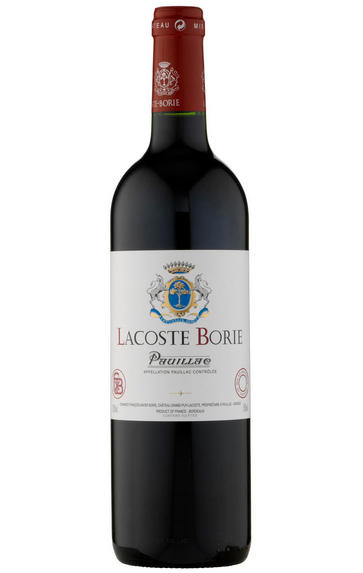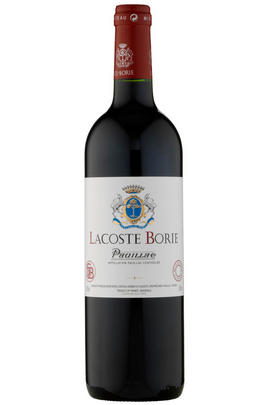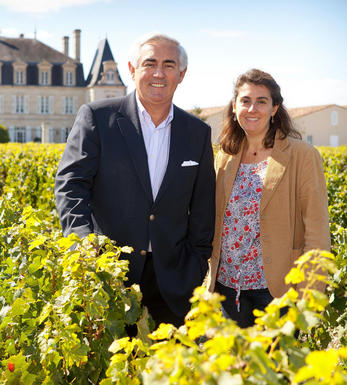
2020 Lacoste Borie, Pauillac, Bordeaux

Critics reviews
The 2020 Lacoste-Borie, which comes in a new label, has an attractive nose with black fruit, pencil shavings and light minty aromas that remain in the background. Fine delineation, though not powerful. The palate is medium-bodied with pliant tannins on the entry, a mixture of red and black fruit, hints of brine and cracked black pepper with an easygoing, seaweed-tinged finish that suggests this will just require a couple of years in bottle.
Drink 2024 - 2038
Neal Martin, Vinous.com (February 2023)
A succulent, charming wine, the 2020 Lacoste-Borie bursts with aromas of sweet berries, cherries, crushed mint and creamy oak, followed by a medium to full-bodied, fleshy palate. It's a blend of 56% Cabernet Sauvignon, 30% Merlot and 14% Cabernet Franc, the latter amounting to the Borie family's entire production this year, as none made it into Grand-Puy-Lacoste.
This 90-hectare estate (some 60 hectares of which are in production), situated in a single block on a gravel dome around the château, has long been a favourite among Bordeaux insiders. Under Emeline Borie's direction, subtle refinements have been made: more than 100 soil pits were dug to better understand the château's geology; herbicides have never been used here, but now 20 hectares are devoted to a trial of organic farming.
Since 2013, a vertical press is used; and since 2012, the new vintage goes to barrel immediately after malolactic fermentation, before being blended early in the new year. Today's wines are a touch more immediately charming and structurally polished than the Grand-Puy-Lacoste of fifteen years ago, yet they have lost none of their classic Cabernet-driven Pauillac character.
Drink 2023 - 2040
William Kelley, Wine Advocate (April 2023)
Perfumed blackcurrants and damons, a nice push of perfumed fruit on the nose, full and juicy, really alive in the glass - you really get the Cabernet Franc aspects which are so nice. Super high acidity, really searing and bright, lovely energy and lightness of touch in the glass while still having the Pauillac signature. Minerality comes across in the wet stone, and graphite edges which give the gravel terroir. Bright and supple with controlled acidity, supple and plush tannins, really plush and high-toned, fresh fruit. Feels well worked, focused and sleek - easy drinking.
Drink 2024 - 2036
Georgina Hindle, Decanter.com (January 2023)
About this WINE

Chateau Grand-Puy-Lacoste
Château Grand-Puy-Lacoste is a 5ème Cru Classé Pauillac estate which has for many years been consistently outperforming its classification. Grand-Puy-Lacoste is located a couple of kilometres west of the town of Pauillac and is owned and run by François-Xavier Borie.
Grand-Puy-Lacoste's 90 hectares of vines (Cabernet Sauvignon 75%, Merlot 25%) are in one block surrounding the substantial 19th century château and lie on deep gravel beds over limestone. The grapes are fermented in temperature-controlled stainless steel vats and the wine is then matured in oak barriques (50% new) for 18 months.
Grand-Puy-Lacoste combines marvellous cigar box perfume with rich blackcurrant and cassis fruit and velvety power which is the epitome of top class Pauillac at its very best.

Pauillac
Pauillac is the aristocrat of the Médoc boasting boasting 75 percent of the region’s First Growths and with Grand Cru Classés representing 84 percent of Pauillac's production.
For a small town, surrounded by so many familiar and regal names, Pauillac imparts a slightly seedy impression. There are no grand hotels or restaurants – with the honourable exception of the establishments owned by Jean-Michel Cazes – rather a small port and yacht harbour, and a dominant petrochemical plant.
Yet outside the town, , there is arguably the greatest concentration of fabulous vineyards throughout all Bordeaux, including three of the five First Growths. Bordering St Estèphe to the north and St Julien to the south, Pauillac has fine, deep gravel soils with important iron and marl deposits, and a subtle, softly-rolling landscape, cut by a series of small streams running into the Gironde. The vineyards are located on two gravel-rich plateaux, one to the northwest of the town of Pauillac and the other to the south, with the vines reaching a greater depth than anywhere else in the Médoc.
Pauillac's first growths each have their own unique characteristics; Lafite Rothschild, tucked in the northern part of Pauillac on the St Estèphe border, produces Pauillac's most aromatically complex and subtly-flavoured wine. Mouton Rothschild's vineyards lie on a well-drained gravel ridge and - with its high percentage of Cabernet Sauvignon - can produce (in its best years) Pauillac's most decadently rich, fleshy and exotic wine.
Latour, arguably Bordeaux's most consistent First Growth, is located in southern Pauillac next to St Julien. Its soil is gravel-rich with superb drainage, and Latour's vines penetrate as far as five metres into the soil. It produces perhaps the most long-lived wines of the Médoc.
Recommended Châteaux
Ch. Lafite-Rothschild, Ch. Latour, Ch. Mouton-Rothschild, Ch. Pichon-Longueville Baron, Ch. Pichon Longueville Comtesse de Lalande, Ch. Lynch-Bages, Ch. Grand-Puy-Lacoste, Ch, Pontet-Canet, Les Forts de Latour, Ch. Haut-Batailley, Ch. Batailley, Ch. Haut-Bages Libéral.

Cabernet Sauvignon Blend
Cabernet Sauvignon lends itself particularly well in blends with Merlot. This is actually the archetypal Bordeaux blend, though in different proportions in the sub-regions and sometimes topped up with Cabernet Franc, Malbec, and Petit Verdot.
In the Médoc and Graves the percentage of Cabernet Sauvignon in the blend can range from 95% (Mouton-Rothschild) to as low as 40%. It is particularly suited to the dry, warm, free- draining, gravel-rich soils and is responsible for the redolent cassis characteristics as well as the depth of colour, tannic structure and pronounced acidity of Médoc wines. However 100% Cabernet Sauvignon wines can be slightly hollow-tasting in the middle palate and Merlot with its generous, fleshy fruit flavours acts as a perfect foil by filling in this cavity.
In St-Emilion and Pomerol, the blends are Merlot dominated as Cabernet Sauvignon can struggle to ripen there - when it is included, it adds structure and body to the wine. Sassicaia is the most famous Bordeaux blend in Italy and has spawned many imitations, whereby the blend is now firmly established in the New World and particularly in California and Australia.


Buying options
Add to wishlist
Description
The 2020 Lacoste-Borie, which comes in a new label, has an attractive nose with black fruit, pencil shavings and light minty aromas that remain in the background. Fine delineation, though not powerful. The palate is medium-bodied with pliant tannins on the entry, a mixture of red and black fruit, hints of brine and cracked black pepper with an easygoing, seaweed-tinged finish that suggests this will just require a couple of years in bottle.
Drink 2024 - 2038
Neal Martin, Vinous.com (February 2023)
wine at a glance
Delivery and quality guarantee